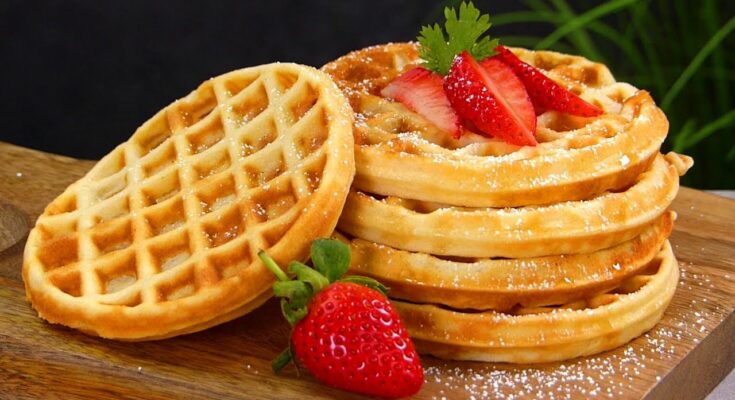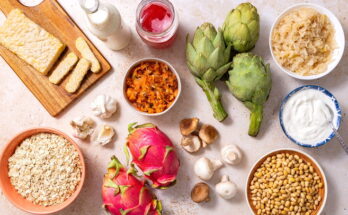Belgian Waffle Recipe: Belgian waffles, with their light, fluffy interior and crispy exterior, are one of the most beloved breakfast treats worldwide. Unlike typical waffles, Belgian waffles are known for their larger size, deeper pockets, and slightly more airy texture, making them perfect for holding an array of delicious toppings.
Belgian waffles trace their roots back to Belgium and became popular worldwide after debuting at the 1964 New York World’s Fair. Since then, they’ve become a breakfast staple in many parts of the world, especially in North America.
What Makes Belgian Waffles Unique?
Belgian waffles differ from regular waffles in several ways. The unique texture of Belgian waffles comes from yeast or beaten egg whites, which give them an airy, almost bread-like interior with a crispy outer layer. Additionally, Belgian waffles have larger grids and deeper pockets compared to standard waffles, making them ideal for toppings like fresh fruits, whipped cream, syrups, and even savory additions like fried chicken or cheese.
Their flavor is also distinct—a subtle sweetness paired with a buttery richness makes Belgian waffles stand out. Their versatility as a dish that can go sweet or savory adds to their appeal, making them a hit at breakfast tables and brunch menus alike.
Ingredients for Authentic Belgian Waffles
To make traditional Belgian waffles, you’ll need some simple, high-quality ingredients. Here’s a list of essentials:
- All-purpose flour – 2 cups
- Sugar – 2 tablespoons
- Baking powder – 2 teaspoons (for quick-rise waffles) or 1 teaspoon of active dry yeast (for yeast waffles)
- Salt – 1/2 teaspoon
- Eggs – 2 large (for added fluffiness, you’ll separate and beat the egg whites)
- Milk – 1 3/4 cups (whole milk gives the best flavor and texture)
- Melted butter – 1/2 cup (unsalted)
- Vanilla extract – 1 teaspoon
Optional ingredients:
- Cinnamon or nutmeg for added warmth
- Chocolate chips, blueberries, or other mix-ins
These ingredients create a batter that’s light, fluffy, and flavorful, while the melted butter ensures a rich taste and a crispy outer layer.
Essential Equipment for Making Belgian Waffles
To make authentic Belgian waffles, having the right equipment is crucial:
- Belgian waffle iron: This is essential as it has deeper grooves and larger grids, which give Belgian waffles their signature look.
- Mixing bowls: For separating and beating the egg whites.
- Whisk or hand mixer: For beating the egg whites to soft peaks.
- Spatula: For gently folding ingredients without overmixing.
Using the correct waffle iron is important because it creates the deeper wells that hold toppings well, so if you’re serious about Belgian waffles, investing in a Belgian waffle iron is a great choice.
Preparing the Batter
- Mix dry ingredients: In a large bowl, whisk together the flour, sugar, baking powder (or yeast), and salt. This helps to distribute the ingredients evenly.
- Separate eggs: Separate the egg yolks from the whites. Place the yolks in one bowl and the whites in another.
- Combine wet ingredients: In a medium bowl, whisk the egg yolks with milk, melted butter, and vanilla extract until fully combined.
- Combine wet and dry ingredients: Pour the wet mixture into the dry ingredients. Use a spatula to gently mix until just combined—do not overmix.
- Beat egg whites: Using a hand mixer, beat the egg whites until soft peaks form. This will give the batter extra fluffiness and a light texture.
- Fold in egg whites: Gently fold the beaten egg whites into the batter with a spatula. Folding rather than stirring keeps the batter airy.
Achieving a smooth, lump-free batter without overmixing is key. Overmixing can make the waffles tough, so it’s essential to handle the batter carefully at this stage.
Tips for Achieving the Perfect Waffle Consistency
The perfect Belgian waffle batter should be slightly thick but pourable. If your batter seems too runny, add a little more flour. If it’s too thick, a splash of milk can thin it out. Remember that the batter will continue to rise slightly as it sits, especially if you’re using yeast.
- For a lighter texture: Let the batter rest for about 10-15 minutes. This helps develop flavor and texture.
- Temperature: Make sure the milk and melted butter are slightly warm, as this helps the batter mix more smoothly and prevents clumping.
- Avoid overmixing: Overmixing can lead to tough waffles, so mix until ingredients are just combined.
Cooking the Waffles
- Preheat your waffle iron: Make sure it’s hot enough to cook the waffles evenly.
- Grease the iron lightly: Even if your waffle iron is non-stick, a light brushing of melted butter or cooking spray can help prevent sticking.
- Pour batter into the iron: Pour a generous amount of batter into the center of the waffle iron. The amount will depend on your waffle maker’s size—about 1/2 to 3/4 cup of batter is typical.
- Close and cook: Close the iron and cook for about 4-5 minutes, or until the waffles are golden brown and crispy.
- Check doneness: Carefully open the waffle iron to check if the waffles are done. They should be golden and slightly firm to the touch.
Cook times may vary depending on your waffle iron, so keep an eye on them for the first batch to get the timing right.
Troubleshooting Common Waffle Issues
If your waffles turn out too soft, it’s often due to undercooking. To fix this, increase the cooking time by 1-2 minutes. For waffles that are too dense, ensure you’ve beaten the egg whites properly to create an airy texture. And if sticking is an issue, a little extra grease or butter should solve it.
Serving Suggestions for Belgian Waffles
One of the best things about Belgian waffles is their versatility with toppings. Here are some classic and creative ideas for serving your waffles:
Classic Toppings:
- Butter and Syrup: A generous pat of butter and a drizzle of maple syrup is the traditional way to enjoy Belgian waffles.
- Whipped Cream and Fresh Berries: Top your waffles with a dollop of whipped cream and fresh strawberries, blueberries, or raspberries for a light, fruity twist.
- Powdered Sugar: Dusting your waffles with powdered sugar is simple yet delicious, adding a touch of sweetness.
Unique Topping Ideas:
- Chocolate Spread and Bananas: Spread some chocolate or hazelnut spread on your waffle and top with banana slices for a decadent treat.
- Caramelized Apples: Sauté apple slices with a bit of cinnamon and sugar until golden, then pile them onto your waffles for a cozy, autumnal flavor.
- Savory Toppings: Try fried chicken with a drizzle of hot honey, or go for a European-style twist with smoked salmon, cream cheese, and fresh herbs.
- Ice Cream Sundae: Turn your waffle into a dessert by adding scoops of vanilla or chocolate ice cream, drizzled with hot fudge or caramel sauce.
The deep pockets of Belgian waffles make them ideal for holding all kinds of toppings, so get creative and mix flavors to find your favorite combination.
Popular Variations of Belgian Waffles
While the classic Belgian waffle is delicious on its own, there are plenty of variations to try if you want to mix things up:
- Chocolate Chip Belgian Waffles: Add a handful of chocolate chips to your batter for a rich, sweet twist. Chocolate chips melt as the waffles cook, creating pockets of melted chocolate throughout.
- Blueberry Belgian Waffles: Fresh or frozen blueberries are a perfect addition to the batter, adding bursts of flavor and a beautiful color contrast.
- Cinnamon Sugar Belgian Waffles: Add a teaspoon of cinnamon to the batter and sprinkle the cooked waffles with a bit of cinnamon sugar for a warm, comforting flavor.
- Pumpkin Spice Belgian Waffles: Perfect for fall, add a bit of pumpkin puree and spices like cinnamon, nutmeg, and cloves to the batter for a seasonal treat.
- Gluten-Free or Vegan Variations: Substitute all-purpose flour with a gluten-free blend or use a dairy-free milk option to cater to different dietary needs without compromising on flavor.
Each variation brings something unique to the table, so don’t hesitate to experiment with flavors and ingredients to find your perfect Belgian waffle.
Storage Tips for Leftover Waffles
Belgian waffles can be made ahead or stored for later use, making them a convenient option for busy mornings. Here’s how to keep them fresh:
- Refrigeration: Allow the waffles to cool completely, then place them in an airtight container and refrigerate for up to 3 days. Reheat them in the toaster or oven to restore their crispy texture.
- Freezing: Belgian waffles freeze very well! Stack the waffles with a layer of parchment paper between each one, then wrap the stack in plastic wrap and place them in a freezer bag. They’ll keep in the freezer for up to 3 months.
- Reheating Frozen Waffles: Pop frozen waffles into the toaster, air fryer, or oven. Avoid the microwave, as it tends to make waffles soggy.
With these storage methods, you can make a big batch of waffles and enjoy them over time with minimal effort.
Making Belgian Waffles for Special Diets
Belgian waffles can easily be modified for various dietary preferences and restrictions. Here are a few tips to make them suitable for everyone:
- Gluten-Free Belgian Waffles: Use a gluten-free flour blend or almond flour in place of regular flour. Check that all other ingredients (like baking powder) are also gluten-free.
- Vegan Belgian Waffles: Replace eggs with a flaxseed or chia seed mixture (1 tablespoon of ground flaxseed or chia seeds mixed with 3 tablespoons of water per egg). Use almond milk or oat milk instead of dairy milk, and replace butter with coconut oil or a vegan butter alternative.
- Dairy-Free Belgian Waffles: Substitute milk with any plant-based milk and use a dairy-free butter or oil in place of regular butter.
By making these substitutions, you can cater to a range of dietary needs without sacrificing the taste and texture of traditional Belgian waffles.
Health Benefits and Nutritional Information
While Belgian waffles are often seen as an indulgent treat, they can also provide some nutritional benefits:
- Energy and Carbohydrates: Waffles provide a good amount of energy, making them an excellent choice for breakfast or brunch. The carbohydrates give you the energy boost you need to start your day.
- Protein: Adding eggs and milk to the batter provides protein, which helps keep you fuller for longer.
- Customizable Nutrition: Adding ingredients like whole wheat flour, oats, or flaxseeds can increase fiber content, while toppings like fresh fruits add vitamins and antioxidants.
- Reduced Sugar Options: For a healthier waffle, you can reduce the sugar in the batter or use natural sweeteners like honey or maple syrup.
Overall, Belgian waffles are a treat that can be customized to meet your dietary preferences and health goals.
Fun Facts About Belgian Waffles
- Not All Waffles in Belgium Are the Same: Belgium actually has several types of waffles, including the Brussels waffle (light and airy) and the Liège waffle (denser with caramelized sugar bits).
- World’s Fair Fame: Belgian waffles rose to popularity in the United States at the 1964 New York World’s Fair, where they were originally known as “Brussels waffles.”
- Deep Pockets by Design: The large pockets are perfect for holding toppings, which is one reason Belgian waffles became so popular as a versatile breakfast food.
- Originally Made with Yeast: Traditionally, Belgian waffles are made with yeast, which gives them a unique flavor and texture. However, baking powder is a popular alternative for convenience.
- Belgian Waffles as Street Food: In Belgium, waffles are often sold as street food and eaten without any toppings—just a sprinkle of powdered sugar.
FAQs about Belgian Waffle Recipe
Q1: What ingredients do I need to make Belgian waffles?
To make authentic Belgian waffles, you’ll need flour, sugar, baking powder, salt, milk, eggs, melted butter, and vanilla extract. For a fluffier texture, some recipes also recommend adding baking soda or a bit of cornstarch.
Q2: How do Belgian waffles differ from regular waffles?
Belgian waffles are thicker and have deeper pockets than regular waffles, making them ideal for holding toppings like fruit, syrup, and whipped cream. They’re typically made with a batter that includes yeast or beaten egg whites, giving them a lighter, crispier texture.
Q3: Do I need a specific waffle maker for Belgian waffles?
Yes, for authentic Belgian waffles, a Belgian waffle maker with deep grids is recommended. It ensures the waffles have the traditional thickness and large pockets for toppings.
Q4: Can I make Belgian waffles ahead of time?
Absolutely! Belgian waffles can be made in advance and frozen. After they’ve cooled, place them in an airtight container or freezer bag. To reheat, pop them in a toaster or oven until they’re warm and crispy.
Q5: What toppings go best with Belgian waffles?
Popular toppings for Belgian waffles include fresh berries, banana slices, whipped cream, maple syrup, chocolate sauce, and even ice cream for a dessert twist. Feel free to get creative with your favorites!
Conclusion
Belgian waffles are a beloved breakfast classic for a reason: they’re delicious, versatile, and relatively simple to make at home. From choosing high-quality ingredients to experimenting with toppings and flavors, there’s so much you can do to customize your waffles. Whether you enjoy them with syrup, fruit, or even savory toppings, Belgian waffles offer a unique experience that combines flavor, texture, and indulgence.
So the next time you’re in the mood for a special breakfast or brunch, try whipping up a batch of Belgian waffles. With this step-by-step guide, you’ll be able to master the art of making waffles that are crispy on the outside, soft on the inside, and full of flavor.



